|
||||||||
|
NEW SCHOLARSHIPConference Report: 'Reign of the Kangxi Emperor'*Asian Civilisations Museum, Singapore, 21 March 2009by Soh Gek Han, Asian Civilisations Museum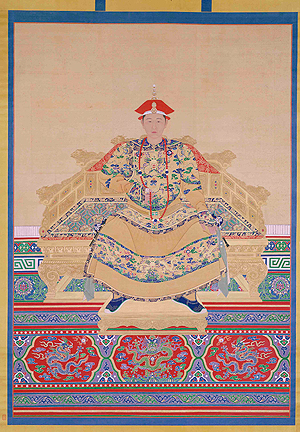 Fig.1 The Kangxi Emperor in court dress. Anonymous court artists. Colour on silk Kangxi period (1662-1722). Courtesy of The Palace Museum, Beijing 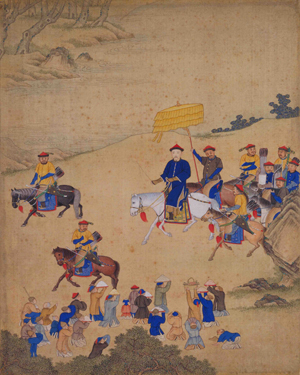 Fig.2 The Kangxi emperor on an inspection tour. Wang Hui and other artists. Colour on silk, 1690s. Courtesy of The Palace Museum, Beijing The 'Reign of the Kangxi Emperor' conference was organised by the Asian Civilisations Museum (ACM) in conjunction with the exhibition 'The Kangxi Emperor: Treasures from the Forbidden City' (13 March-14 June, 2009). The Kangxi (康熙) emperor was one of the longest ruling emperors in Chinese history, whose reign (1662-1722) saw the consolidation of Manchu rule over China and the expansion of the Qing empire. This conference focused on the life and personality of the Kangxi Emperor and the social customs and foreign policy during his reign. The first session of the conference focused on the life and personality of Kangxi. In a paper entitled 'Early Modern Cosmopolitanism and the Kangxi Emperor', Pamela Kyle Crossley (Dartmouth College) argued that the emperor can be better understood as a 'cosmopolitan ruler', with a remarkable mastery of various skills and technological knowhow. Hence, he stood in contrast against his grandson, the Qianlong Emperor who succeeded his son, Yongzheng, even despite the fact that Qianlong promoted an image of himself as a transcendent ruler over the empire's various civilisations. Kangxi's readiness to embrace new technology and knowledge, and his desire to extend his own cosmopolitan practice to the rest of the population, made him comparable to the European rulers of the time. Michael G. Chang (George Mason University) presented a paper on the emperor's southern tours (1684-1707). He suggested that it was necessary to move beyond the traditional view that such imperial tours were aimed solely to garner popular support among the Han Chinese population for the Qing rulers and bannermen. Instead, Chang offered a new perspective suggesting that the tours were also ideological endeavours and displays of military prowess and ethnic difference. The earlier tours(1668-early 1680s) were, he argued, in fact an extension of military manoeuvres and seasonal hunts. However, such activities were considered unbefitting for the Son of Heaven and, in order to legitimise the tours, the tour itinerary included ritual obligations such as paying respects at the ancestral tombs or performing ritual sacrifices at Mount Tai in Shandong province. Chang mentioned that the first southern tour was also preoccupied with military activities. In addition, the gifts of imperial favour—which took the form of spoils of the hunts and Inner Asia 'exotics'—were handed out to generals and even Han-Chinese scholar-officials as symbolic domination and incorporation into the empire. 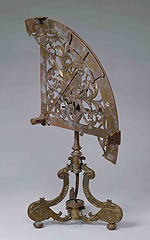 Fig.3 Arc quadrant for calculating zenith distance, Kangxi period. Courtesy of The Palace Museum, Beijing 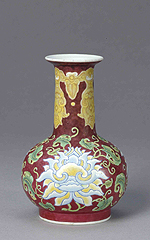 Fig.4 Vase with carved reign mark and enamel decoration (falangcai, 珐琅彩), possibly painted by a European artist in the palace workshops. Jingdezhen, Jiangxi province and Palace Workshops, Beijing. Kangxi mark and period. Courtesy of The Palace Museum, Beijing 'The Kangxi Emperor as Patron: A Scientific Approach to the Arts', a paper presented by Regina Krahl, discussed the artistic achievements during the emperor's reign. The emperor was committed to fulfilling his role as a patron of the arts, a duty as well as a privilege for China's rulers. Under court order the imperial porcelain production at Jingdezhen in Jiangxi was revived and several innovations in the porcelain industry followed, including the creation of the famous 'peach-bloom' glaze and enamel decoration on porcelain. In addition, the emperor was drawn to the scientific knowledge introduced by the Jesuit missionaries. Similar to Crossley, Krahl discussed the devices introduced by the Jesuits, but she focused on the manufacture and design of the scientific instruments that they introduced to the Qing court, and highlighted how these instruments were treated as works of art and given imperial inscriptions. While the European presence in imperial workshops was welcomed, Krahl asserted that the skill of the Jesuits was manifested in technical, rather than artistic, ways. Despite Kangxi's openness to new knowledge, in the realm of painting he did not appreciate the 'scientific' practice of European art that favoured the use of chiaroscuro, linear perspective and verisimilitude. 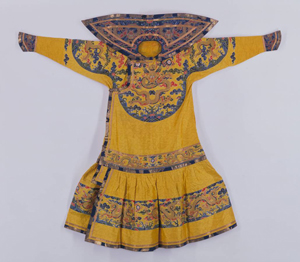 Fig.5 The Kangxi emperor's yellow court robe embroidered with clouds and dragons. Patterned silk gauze with embroidery and brocaded trimmings, Kangxi period. Courtesy of The Palace Museum, Beijing 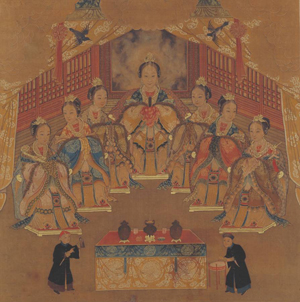 Fig.6 Painting of shamanistic female goddess hung at the Palace of Terrestrial Tranquility (坤寧宫 Kunning gong), the site of daily shamanic rituals in the palace. Colour on silk, Kangxi period. Courtesy of The Palace Museum, Beijing The second panel discussed the material culture and customs during the Kangxi Emperor's reign. Ren Wanping (The Palace Museum) examined the clothing and costumes of the emperor, empress, concubines, court officials, scholars as well as commoners. She noted that Manchu court dress abandoned the traditional form of loose robes, and incorporated features such as tapered sleeves and horse-hoof cuffs, derived from the semi-nomadic lifestyle of the Manchus. Wang Honggang (Shanghai Academy of Social Sciences) discussed the shamanistic beliefs and practices in Kangxi's court and showed how they developed from a tribal belief to a national system of religion and worship. Shamanistic state rituals were created by the founding Latter Jin/Qing emperor Nurgaci and his successors, Hung Taiji and the Shunzhi Emperor. Shamanism became increasingly institutionalised and standardised, especially following the publication of the Imperially Commissioned Code of Rituals and Sacrifices of the Manchus (Qinding Manzhou jishen jitian dianli 钦定满洲祭神祭天典礼) in the mid-eighteenth century. This 'shamanic code' was disseminated among the ordinary Manchus and bannermen and became the standardised manual for ritualistic practices. The last paper in this panel was on death rituals. Frances Wood (The British Library) argued that death rituals and burials during the Kangxi Emperor's reign were not bound by rules and regulations. After the death of his grandmother, the emperor broke many ritual protocols: he cut off his queue, an act that was reserved for mourning an emperor; he allowed his grandmother's coffin to remain in the palace past the Lunar New Year; and, he sealed the coffin lid himself. In particular, the emperor abandoned the Manchu funeral tradition of cremation (his predecessor the Shunzhi Emperor had been cremated) and the Eastern Qing Tombs (Qing Dongling 清东陵) complex was chosen with geomantic considerations as his burial ground. Wood offered the view that the Qing Dongling complex was an aesthetical failure as compared to the Western Tombs (Xiling 清西陵), where Kangxi's successor, the Yongzheng Emperor was buried, but she concluded that the emperor could hardly be blamed for such aesthetic failings. Being a non-conformist who went against ritual prescriptions following his grandmother's death, the emperor probably did not take imperial burial rituals seriously. 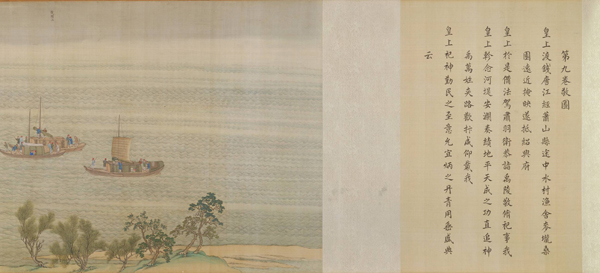 Fig.7 Pictorial album featuring diplomatic ties with Ryukyu (Okinawa), which sent a mission to Qing court every two years during Kangxi's reign. Ink and colour on silk, 1690s. Courtesy of The Palace Museum, Beijing The final panel looked at the foreign policy of the Qing rulers. Peter C. Perdue's (Yale University) paper, 'The Kangxi Emperor, Russia and the Jesuits at Nerchinsk: Language, War and Ethnicity', offered new directions for the study of the Nerchinsk settlement that was signed between the Qing and Russian empires in 1689. Perdue noted that Chinese and Russian scholarships have focused on narrow issues related to territorial gain and loss. They either play up or de-emphasise the role of military threat. Putting aside such nationalistic disputes, Perdue proposed new directions for scholarship on this treaty: the role and significance of the Jesuits in the negotiation process; the desire of the two empires to control the shifting border populations for taxation and extraction of services; and, the presence of a third party, the powerful Zunghar Mongols as a possible partner to the Mongols. Geoffrey Wade's (Institute of Southeast Asian Studies) paper examined Qing foreign policy to the south during Kangxi's reign, focusing on the incorporation of Yunnan and Taiwan into the Qing empire, as well as the foreign relations with Vietnam and Siam. Despite the Kangxi Emperor's rhetoric that the Qing empire could gain nothing from the possession of Taiwan, his reign in fact witnessed imperial expansions comparable to European imperialism. The 'tributary system', another device used by the Qing rulers, hid mutual commercial advantages behind the facade of hierarchical power relations. Wade noted that unless such rhetorical devices are deconstructed, they will remain as obstacles to understanding the Chinese past. This one-day conference at the ACM attracted an audience of about two hundred people and provided a fuller understanding of the life and times of the Kangxi Emperor. Several of the papers challenged traditional scholarship: Michael Chang re-examined the intentions behind the emperor's southern tours; Geoffrey Wade advanced a critique of the nature of Qing foreign policy in the south; and, Peter C. Perdue suggested new dimensions in the study of the Nerchinsk settlement. The conference covered different areas of concern by speakers who specialise in both history and art history, and opened up new areas for further research. The full list of speakers and their papers can be found below. For more information, contact the museum at nhb_acm@nhb.gov.sg. *This conference was made possible by the generous sponsorship of the Kwan Im Thong Hood Cho Temple. The author would like to thank the Palace Museum, Beijing for allowing the publication of the images, as well as Kan Shuyi, Tan Huism, Ng Wan Gui, Crystal Tan, Gauri Krishnan, Jack Chia and Geremie Barmé for their kind assistance. Speakers and their papers:Participants in the conference. Top row (left to right): Geoffrey Wade; Frances Wood; Regina Krahl; Wang Honggang; Pamela Kyle Crossley; Ren Wanping. Bottom row (left to right): Michael G. Chang; Tan Huism, Deputy Director, ACM; Peter C. Perdue; Yuan Shaoliang, supporter; Kenson Kwok, Director, ACM. Courtesy of the Asian Civilisations Museum. Pamela Kyle Crossley, Micheal G. Chang, Regina Krahl, Ren Wanping, Wang Honggang, Frances Wood, Peter C. Perdue, Geoffrey Wade, |